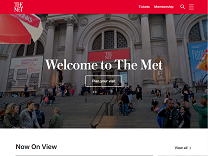“In the second half of the sixth century, China, long divided into north and south, is further subdivided into the northwestern and northeastern regions ruled by different factions of the once-powerful Northern Wei empire. The reunification of China under the subsequent Sui and Tang dynasties initiates a period of prosperity, trade relations, and far-reaching influence. Chang’an, the capital, is one of the largest and richest cities in the world. Art and literature flourish, reflecting influences from the different cultures with which China maintains diplomatic and trade relations. In addition to painting and calligraphy, Tang is noted for its Buddhist sculpture, metalwork, and ceramics, both brightly glazed tomb figures and white-bodied vessels. After the fall of the dynasty in 907, China is once again divided into north and south, ruled by competing dynasties and kingdoms.”
Masters include Li Bo (701–762), Du Fu (712–770), Bai Jui (772–846), and Gao Shi

